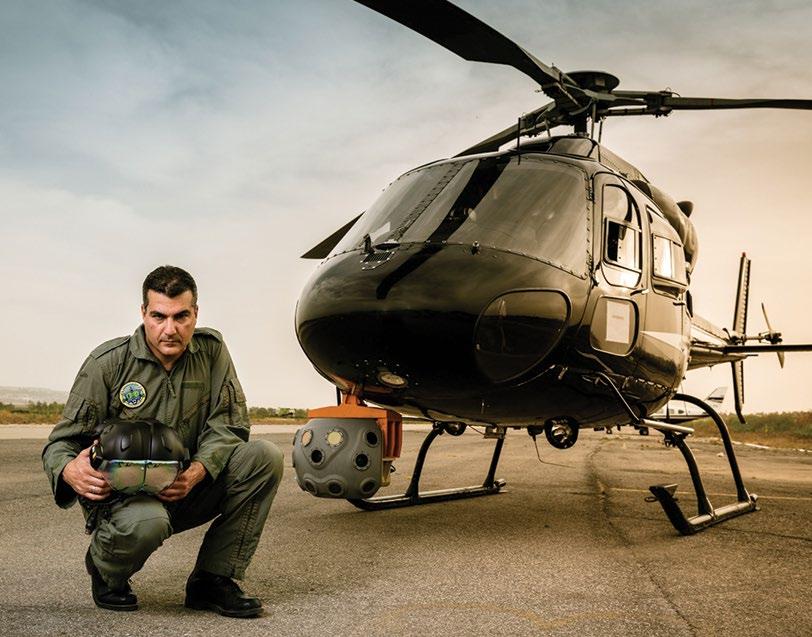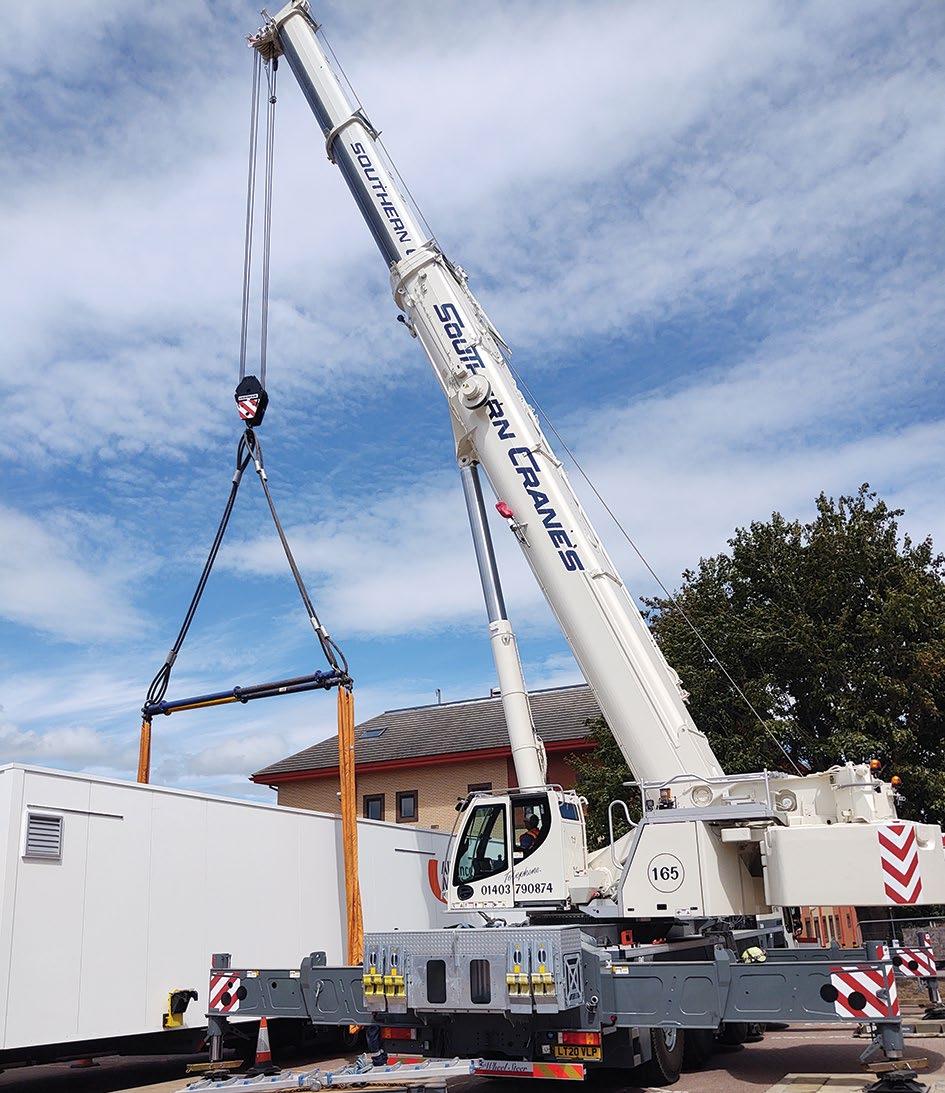
6 minute read
Increasingly remote
The operation of machinery via remote controls has typically intended to allow operators to place themselves in the most beneficial position, in terms of safety and view of the work. With the advent of radio remote controls, operators are no longer confined to a stationary control point whether that be at the end of a trailing lead, in a cab, a platform, or at the side of a machine. More recently however it has also begun to take on a slightly wider meaning and purpose.
From the ground up
A new Israeli remote control technology company UltraWis has recently completed its site trials of a remote operating systems for tower cranes called WideSite. We spoke with co-founder Lior Avitan to find out how the company has adopted similar technology used in military combat systems on fighter jets and by helicopter pilots to develop what UtraWis claims is the first remotely operated tower crane system on the market.
Prior to founding UltraWis in 2019 Avitan and Erez Gernitzky spent more than 30 years between them with Israel’s largest defence company Elbit Systems, working on the technology behind its helmet mounted display systems used by military pilots. Most recently, Avitan was responsible for developing night vision sensor system BrightNite, while Gernitzky spent around 20 years working on imagery processing and algorithms. Given how the move into cranes might not seem like a logical transition, Avitan explains how the idea for WideSite came to him after spotting a tower crane at work while studying for a master’s degree in 2016.

(L-R) UltraWis founders Erez Gernitzky and Lior Avitan
“Each day between my classes I couldn’t help noticing the tower crane, how it was being operated and the deficiencies resulting from its restricted field of view. Right away I knew we could utilise the technology used to help pilots in their cockpits to assist tower crane operators – and that’s when the idea for UltraWis was born.”
Part of Incubit - Elbit Systems’ deep-tech incubator - UltraWis began adapting military grade technologies in image processing, stability, 3D modelling, and augmented reality, to allow tower crane operators to remotely control the crane from a cabin or office located on site. Less than a year in the company was granted $900,000 from Israel National Insurance Institute’s Manof Fund. Designed to support a wide range of projects that promote safety in the workplace, it recognised the potential the system could have on preventing accidents within the construction industry. enabled us to add to our team and push forward to develop a working model for a construction site.”

The WideSite multi sensor camera unit.
Designed to be installed on the jib of any make or model tower crane, WideSite combines a multi sensor camera unit with a replicated tower crane control station, two high definition screens and speakers. It has also developed a ground cabin but acknowledging that many sites will have their own space, can easily set up the control station in any building located within 300 metres of the crane. Making use of artificial intelligence and machine learning, the system constantly monitors the site and displays
WideSite allows tower crane operators to control boom movements from the ground augmented reality graphics over the live feed to provide the operator with a wide variety of information, such as hook heights, weight of the load and the projected location of load within a variance of just 100mm. It can also detect and notify the operator of other cranes or construction equipment that might impact the operation of the crane.

“We have designed WideSite to be as similar to operating a tower crane from the elevated cab as we possibly can. The addition of real time overlay graphics has been designed to be very intuitive and just as pilots no longer have to look down at the cockpit in order to fly, crane operators will have all the information they need on the screen directly in front of them.”
Outside in
Given the overwhelming adoption of remote control technology in recent years the development of a system like this seems an obvious step. What is more surprising perhaps is that it has taken a company from outside the industry to develop a working solution. Explaining why this might be the case Avitan said: “Before we started developing this solution, we asked the question as to why none of the tower crane manufacturers had developed such a system yet. I think part of the reason is down to manufacturers preferring to concentrate on the tower cranes themselves and improving their capabilities but mostly I believe it is because the system requires highly advanced imagery processing and sensing software to make it a practical reality. Very few people will have the knowledge and experience that we have in this area, or the ability to implement a proper working solution.”

Successful trial
As part of site trails UltraWis worked with Liebherr’s Israeli distributor Top Engineering to install its system on a five tonne Liebherr 71 EC-B tower crane on a construction site near Hadera, north of Tel Aviv. The training of the tower crane operator took place within the ground cab and involved a series of theory and video based learning before hands on training on the remote system. “The system is very intuitive and after only 10 hours of using WideSite the operator informed us that he no longer wanted to return to the tower crane cab to work anymore!”
During the trial the company encountered a small number of challenges – chiefly around the level of vibration that occurs when lifting a load at the end of the jib which distorted the view. The addition of inertial measuring units (IMU) combined with a new algorithm however proved more than capable of stabilising the images. Avitan goes on to explain how the trials also provided a number of unexpected benefits.
“Our sensing unit has two cameras on either ends of the jib which provide 360 degrees of sight - essentially providing visibility of the entire site. As such we are able to monitor the whole area and have started pushing it out to cloud and mobile applications to give customers visibility of the site as it progresses.”

The system can be used to provide visibility and monitoring functions of the site in both 2D and 3D
More than just providing a live feed of the site however the high tech motion detection system is able to track employee and equipment movements and, if required, notify management on a range of things like whether or not a person is wearing his safety helmet or hi-vis vest. It is also able to provide a heat map of where personnel have been located each day.
Product rollout
Following its successful trial in Israel, the company is looking to carry out further trials in Europe and the USA and is holding advanced discussions with a leading - but unnamed - manufacturer, while also looking to target end users and rental companies by the beginning of next year.
Although the system is now available on tower cranes the company says that WideSite can be installed on a range of cranes, such as overhead gantry, marine and ship to shore cranes. As well as providing benefits in safety and productivity for a number of industries the company is also hoping that it might play a role in reducing the risks of lone workers. By having crane operators working from the ground and closer to others on site, it effectively eliminates the need to have complicated rescue and additional safe systems of work in place.










